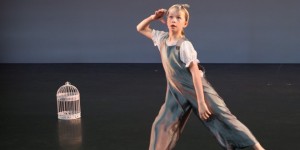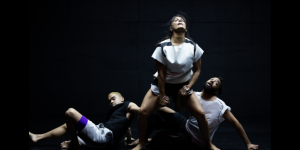IMPRESSIONS: Kei Takei’s Moving Earth Orient Sphere at Lumberyard in the City Winter Festival

New York Live Arts
January 26, 2018
LIGHT, Part 44 (Bamboo Forest)
Choreography: Kei Takei / Music: Seiichiro Sou
Set Design: Renta Kochi / Performance: Moving Earth Orient Sphere
Solo from LIGHT, Part 8 (1974)
Choreography, Performance, Costume, and Props: Kei Takei / Music: Yukio Tsuji
It was before Watergate, AIDS, and 9/11 when Kei Takei showed the first part of her epic dance series, LIGHT, in 1969. A movement poet influenced by Noh theatre — which features slow pacing, the act and the speed of it — she has added standalone stanzas to LIGHT for almost fifty years.
Now, the world both different (#MeToo, @realDonaldTrump) and the same (despite decades of handwringing, concert dance is still kicking), she returns to New York after a 17-year hiatus with two works as part of Lumberyard in the City Winter Festival at New York Live Arts. The first, LIGHT, Part 44 (Bamboo Forest) from 2016, receives its U.S. premiere while the second is a solo from LIGHT, Part 8 (1974).
Although she was born and currently lives in Japan, it’s a homecoming of sorts for Takei. She attended Juilliard in the ‘60s and debuted sections of LIGHT here. Her biography indicates that she’s likely a few years on one side or the other of 70, but she dances — in both pieces! — like a teenager, feral and unencumbered with the regret and fatigue that can accumulate on a body over the years, like tree rings.

Everything you need to know about Bamboo Forest can be found in the company’s name: Moving Earth Orient Sphere. Takei and her multigenerational dancers squat in a split-legged stance as they stride to a soundscape of thumping drums, crashing cymbals, and clanging bells, hitting the beat squarely in the middle. Their arms carve and arc through space, sometimes gently, as if they're branches yearning toward the sun, while, other times aggressively, as if they are warriors brandishing swords.
In the program notes, Takei cautions that she isn’t trying “to express anything in particular in Bamboo Forest.” Yet it’s hard not to interpret the spines bowing forward, backward, and side-to-side as tree trunks submitting to the will of the wind. When clutches of performers rest against the green-roped sidelines, their alert faces suggest the enchantment of the woods where quiet doesn’t equal stillness. Just because nothing is happening to us, doesn’t mean that something isn’t happening to them.

Bamboo Forest unfolds over a half dozen or so episodes that vary little in content and dynamics. As the rhythm — from the music, of the dancers — thuds relentlessly, repetitively, the piece begins to resemble a military drill, all rigorous marching and slicing gestures. The bamboo forest is, as Takei says, “a mystical place”; it is also a grove, a place of configuration and expectation.
Everything you need to know about LIGHT, Part 8 can be found in the first minute. Takei, in baggy panties, prances around a cube, soft and white. Chortling gleefully, she leans in and yanks out a hank of fabric that looks like a homemade Halloween ghost: a blob at one end, and at the other, dangling bits later revealed to be leg- and armholes. She lashes this around her body and then reprises the action until the cube is no more and she appears covered in tumors.
Unlike Bamboo Forest, the contrivance only grows more amusing as Takei skitters on her heels and natters to herself. At the end, she lands on her back, her feet and hands pawing at the air. The fabric has consumed her to the point where stagehands must carry her off. But why has she let it? From greed? From need?
The piece seems too innocent and playful for such heavy readings. Takei is having fun, and so am I.
The Dance Enthusiast Shares IMPRESSIONS/ our brand of review and Creates Conversation.
For more IMPRESSIONS, click here.
Share your #AudienceReview of performances for a chance to win a prize.















